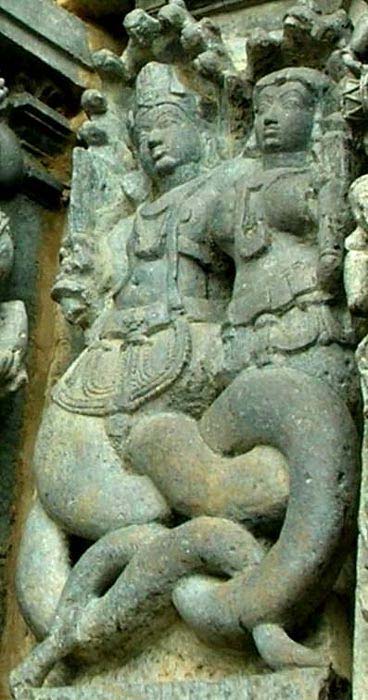
Flood Reveals Ancient Idols Holding Secrets to Early Hinduism and a Long-Lost Civilization
Indian authorities have announced a dramatic discovery on a riverbank in the south-west of the country. Fishermen found some Hindu idols on the banks of the Pamba River in Kerala State and it is believed that there are more to be discovered. The fishermen have apparently come across a major archaeological site, one that could change our understanding of the development of Hinduism and the history of a long-lost civilization.
Treasures in Tree Roots
Last month, some fishermen were rowing on the Pamba river near Aranmula in Kerala after a recent flood. As they were rowing towards a river bank that had subsided, they spotted something that aroused their curiosity. There was something unusual in the roots of an upturned tree that had been felled by the flooding. After a brief investigation, they realized that they had discovered some terracotta figures and they immediately contacted the Kerala Department of Archaeology.

The ancient idols were found on the riverbank after a flood. (Krishnaraj K/Facebook)
The news of the discovery excited the experts at the department. This is because earlier this year some terracotta figurines were found in the same river, including “male and female figurines, snakeheads, a bust of a man and a twin female terracotta figurine,” according to The Hindu. A team of specialists investigated the site and retrieved the rare artifacts. It appears that the recent floods had dislodged the idols from some unidentified location and they had later become entangled in the roots of an upturned tree.
- Why Did 2,400-Year-Old Stone Idol in Siberia Undergo Racial Realignment to Look Less European?
- Saraswati: Hindu Goddess of Aesthetics and Protector of the Universe
- Debate rages as legal case points to evidence that Taj Mahal was once a Hindu temple
Ancient Idols of Hindu Gods and Demi-Gods
After the retrieval of the idols, work began to recover other artifacts on the river bank. To the delight of the archaeologists more were discovered. They were easily identified as related to traditional Hindu gods and demi-gods. A majority of the idols have seven faces, which is very common in representations of the divine in Indian religion.
According to Professor Krishnaraj of the Kerala Department of Archaeology the “concept of Sapta Kanya (seven virgins) or Sapta Matrika (a group of mother goddesses) is a common theme in the idols”, as reports the News Minute Website. One of the terracotta idols is of a group of women sitting together and this could represent the seven virgins or mother goddesses. In southern India, the seven mother goddesses are still commonly worshipped to this day.

The Seven Mother Goddesses (Matrikas) Flanked by Shiva-Virabhadra and Ganesha. (Ms Sarah Welch/CC BY SA 4.0)
Some male figures and Naga figurines were also found on the riverbank. In Hindu mythology, the Naga are a race of half-men and half-serpents, usually cobras. They inhabit a netherworld and occasionally took the form of humans. Interestingly, they are often regarded as the guardian of bodies of water, which could explain why they were found on a riverbank.
The experts are confident that they have found an ancient place of worship. This is because some sculptures known as shilpams were also found and these are used to this day for ritual offerings to Hindu gods. There was possibly a shrine or temple where offerings were made to the seven mothers or the Naga divinities at the site.

Hoysala sculpture of a naga couple in Halebidu. (Public Domain)
The Mysterious Pamba Civilization
It has been speculated that the idols are possibly from the Pamba River Civilization. This was a significant urban culture that was as advanced as the better-known Indus Valley Civilization, but relatively little is known about its history. It is also possible that the holy site which housed the idols was constructed by local tribal peoples at some date.
- The Curse of the Nenets Idols of Vaygach Island, the ‘Territory of Death’
- Oldest Wooden Statue in the World: The 11,000-Year-Old Shigir Idol
- Modern Hindus Forbidden From Eating Beef But Ancient Hindus Ate the Sacred Cow
The artifacts will be subjected to thermoluminescence dating to discover when they were made. This can help researchers to discover not only the age of the idols, but also their likely origin and whether or not they came from the Pamba River culture.
The find of the terracotta figures is an exciting one as it can help researchers to understand the development of Hinduism. This discovery is also underlining the historical importance of the Pamba River Valley for Indian civilization. If it can be established that the idols are from this culture, it can help us to better understand this enigmatic society. Local archaeologists are very hopeful that they will find more terracotta figures as they continue to excavate the riverbank.

A terracotta figurine of a man’s bust previously unearthed from the banks of the Pampa at Edayaranmula. ( The Hindu)
Top image: Some of the ancient idols found alongside a riverbank in Kerala, India. Source: Krishnaraj K/Facebook
By Ed Whelan















